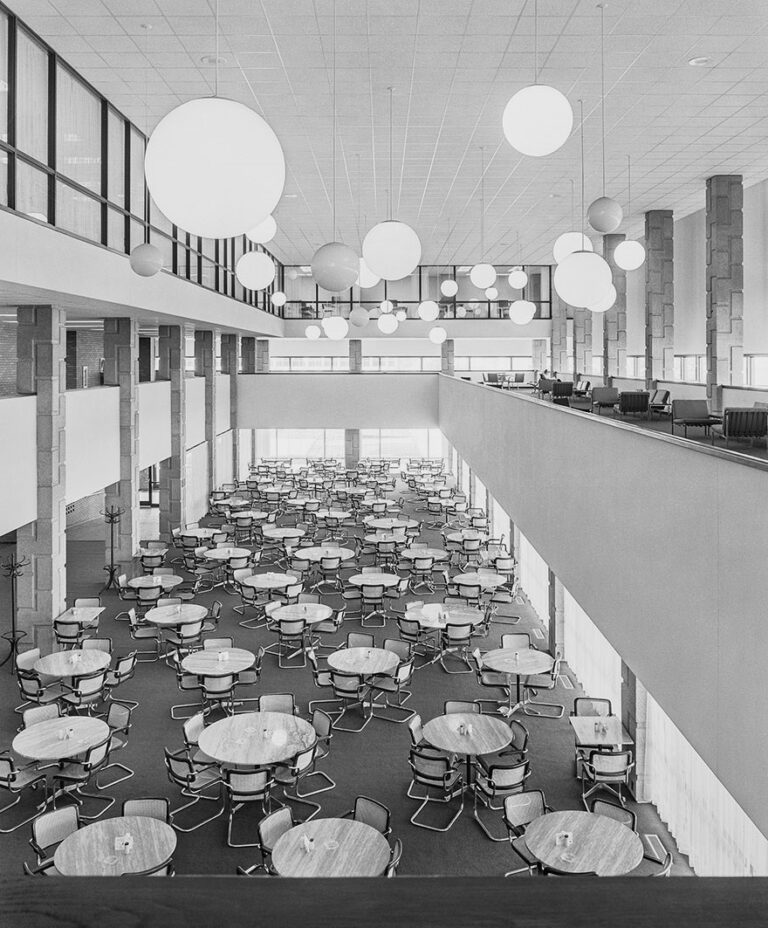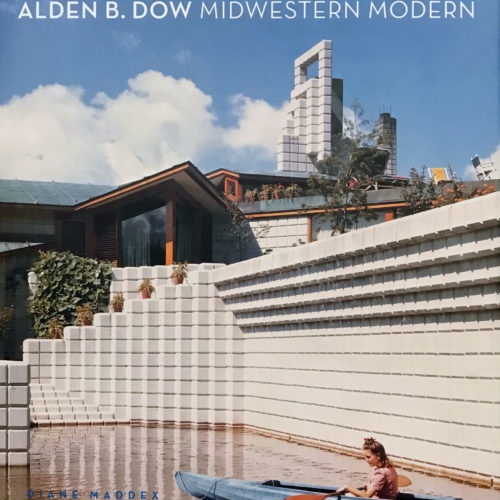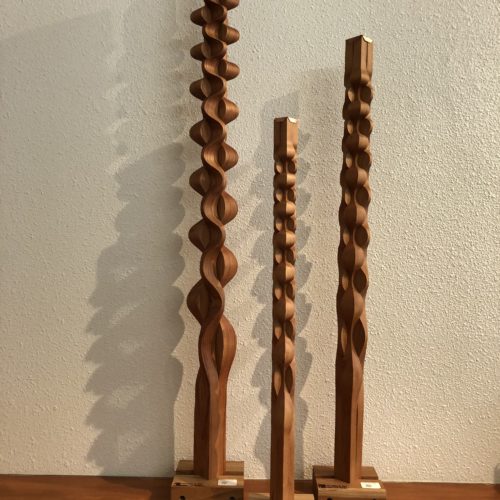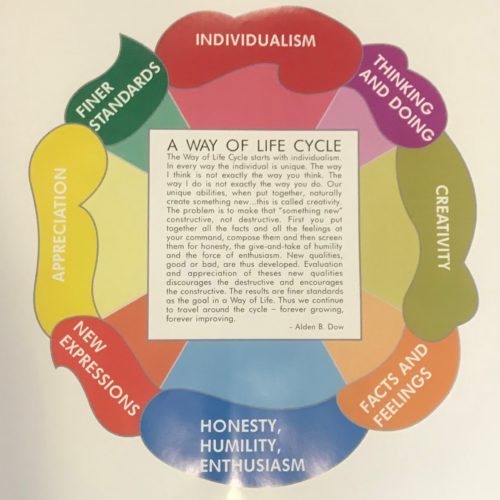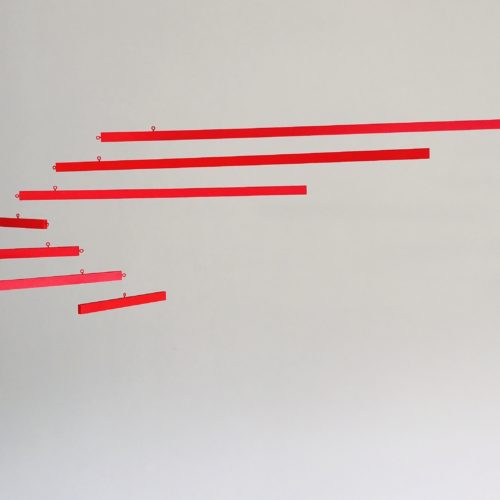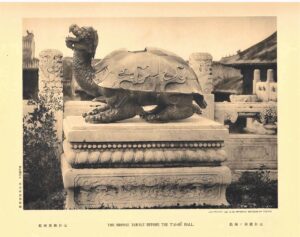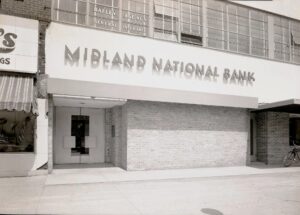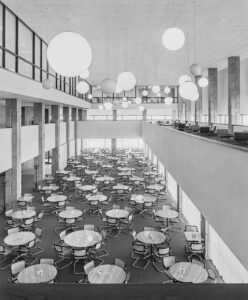Thank you DWELL.com for this wonderful story on Alden B. Dow’s collections of iconic furniture, textiles, and decorative arts. His eye for quality pieces has stood the test of time as he composed their order within his own home and studio, to create a personal space of inspiration and beauty, when they were first being introduced as new innovative designs.
Dow’s doctrine of composed order states that harmony can be achieved based on how items are placed and relate to one another in a space. Dow regularly would explain composed order as an arrangement of flowers, each flower unique in its solitude—but integral in contributing to the overall wholeness of the bouquet.
“Any form is made up of parts that are free to express themselves as long as they improve the quality of the whole,” he said. In a trip to Japan with his family in the early 1920s, 18-year-old Dow discovered his passion for the aesthetic philosophy, and then used it as his guiding philosophy in his future designs.
“Seeing Japan with my own eyes was a revelation,” he said. “I saw composed order in landscaping, buildings, floral arrangements…in fact, it seemed to be the backbone of Japanese culture.”
Dow’s affinity for composed order not only influenced his commercial and residential designs for clients, but also the interior design of his very own home in Midland, Michigan. Much meditation went into his selection of furniture and decor, along with the positioning of these items to create a harmonious home for himself and his family.
Avram Golden
“A pile of rocks is a pile of rocks, but when man composes them, it becomes a balance, a thing of beauty,” he said. Throughout Dow’s home—from the furniture to the groupings of pottery and decorative objects—you can see Dow’s composed order in motion.
“Everything is equally important. You don’t walk into any space where there is one prominent feature. Everything is playing a part—geometry, texture and pattern,” says Craig McDonald, director of The Alden B. Dow Home and Studio. “It is all a balance of color, texture, form and shape to create a feeling that impacts creativity, productivity and enjoyment.”
One of the most exciting features of composed order within Dow’s home is the architect’s selection of iconic midcentury modern pieces that, at the time, were radical in design. His excitement for cutting-edge forms can be seen throughout his home as he integrated new technologies and materials like Saran™. In his architectural design, Dow wasn’t afraid to be the first person to try something out, and that M.O. extends into his furniture and decorative collection at home.

Avram Golden
Dow’s passion for innovation was instilled in him by his father Herbert Henry Dow, head of Dow Chemical Company, who used to tell him, “Never copy. If you cannot figure out a way to do a thing better than it has been done before, don’t do it, for otherwise you are just inviting cut-throat competition.”
From Jan Ekselius’ iconic Etcetera chair and ottoman to his arrangements of Natzler and Harrison McIntosh ceramics, Dow’s house lives and breathes his guiding principle of design, composed order.
“Every element is so thought-out and so planned, but in such a way that it’s relaxing and comfortable,” says McDonald.
Iconic Furniture in Dow’s Home
Hans Wegner’s sculptural Valet chair for PP Møbler showcases the midcentury modern Danish designers concept of “Organic Functionality,” pairing usefulness with soft edges and fluid shapes. As with his previous chairs — Chinese chair, Peacock chair, and Y chair, the Valet chair showcases Wegner’s use of simple materials and structure. Located in Dow’s dressing room next to his built-in dresser, the chair’s back offered a perch for the snazzy dresser to hang his coat, and the seat flips up, providing a place to hang a pair of slacks.

Avram Golden
“He had great appreciation and early use of these pieces. He was so enamored and excited about other people’s creativity. His collections have been in place since the early ’50s and ’60s,” says Lisa Quinn, marketing coordinator at Alden B Dow Home & Studio. “These styles of furniture, textiles and decorative arts have been in good standing for generations, and they haven’t lost their appeal. Mr. Dow was aware of that as they were coming out and being introduced to the world. He had an eye for quality, innovation, and design.”
Lounges make an appearance throughout the house as places for relaxing. Located in daughter Barbara Dow’s bedroom is Jan Ekselius’ iconic Etcetera chair and ottoman for J. O. Carlsson, Vetlanda.

Avram Golden
“He was always so excited about other people’s designs,” says McDonald. “There was a concentration of variety in the home.”
In the sitting room, two Eames Lounge Chairs and Ottomans (Ray and Charles Eames’ most iconic chair) are situated side by side in front of bookcases—the perfect place to kick up your feet and curl up with a good read. Originally intended to be Vada’s study, the room was commandeered by the entire family as they spent most of their time together gathering in the cozy room—warming themselves by the fire, watching the toy trains chug along above in the loft, and gathering around the Christmas tree during the holidays.

Avram Golden
Other chairs in the Dow residence were designed by Dow himself and covered in Knoll fabric or manufactured by the furniture maker Herman Miller. “He had a close connection with Knoll and Herman Miller,” says McDonald.
Husband and wife Hans and Florence Knoll of Knoll Associates became good friends with Dow as their professional paths overlapped, and Dow had several of his chair designs upholstered in their fabric. In the living room, a pair of arm chairs are upholstered in a vibrant, poppy orange fabric and in the bedroom hallway, a midcentury reinterpretation of the wingback chair is covered in a black-and-white textile.

Avram Golden
Dow’s friendship with the Knolls, and their shared passion for design, can be seen throughout their business correspondence. In a letter dated March 3, 1955, Hans Knoll—son of the modern furniture maker—had his assistant send Dow a letter that read: “Just before Mr. Knoll left for a trip yesterday he asked to send you the enclosed newspaper article ‘Modern Designs in Churches win’ which he thought would be of interest to you.”
Other correspondence between the Knolls and Dow show their collaboration on projects like The Dow Chemical Company, the chemical manufacturer owned by Dow’s father. Dow recommended Knoll fabrics and furniture for various projects over the years. A letter to Dow from Florence Knoll dated August 10, 1956 reads: “If you could arrange to spend some time with me on your next visit to New York, I would appreciate the opportunity to review with you our handling of this project…”
Other furniture designed by Dow for the home was manufactured by Herman Miller, like the extra-long buffet table and a horseshoe-shaped sofa in the game room, the most vibrant and exciting room in the Dow house. Located on the ground floor, the L-shaped room includes two spaces for the family to relax and play—a seating area in front of the fireplace and a theater for watching movies and putting on performances.

Avram Golden
A letter to Dow dated February 20, 1941 reveals the care and attention to detail the furniture maker Herman Miller took to bring Dow’s designs to life: “We are sorry but we believe we have some bad news for you. We had planned to ship your buffet, sofas, and tables this week as we informed you in our letter of February 5. However, it has taken us longer than we expected to assemble it and get everything just right. These pieces are now in the Finishing Room. The sofa is being upholstered.…We know that this will be a disappointment to you, and also was to us, but we believe that large pieces like this should be perfect before we can send them out.”
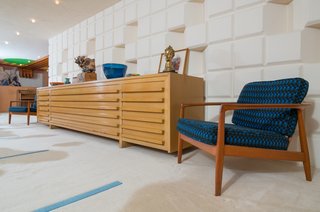
Iconic Decorative Objects in Dow’s Home
Dow’s philosophy of composed order also extended into the way he accessorized his home with artwork, textiles and other decorative objects.
Placed on the Dow-designed horseshoe-shaped sofa in the game room are pillows covered in fabric by the internationally known textile designer Jack Lenor Larsen, famous for his unique weavings using multi-colored naturals yarns. The pillows showcase Larsen’s distinct textiles—a blend of wool, cotton, silk, linen, jute and metallic yarn. Upstairs in the dining room, Larsen’s fabrics also can be found on the pillows on the built-in sofa. “It wasn’t about being static,” says McDonald. “He had a appreciation for quality.”

Avram Golden
A pottery enthusiast with hundreds of ceramics found throughout the house, mostly American and Scandinavian pieces, Dow was intentional with not just his selections, but the placement of them in each room.
“Part of his composed order, there is always intention with placement— why there were three pieces of pottery in one place, as opposed to five in another,” says Quinn.

Avram Golden
A grouping of pottery was dictated by form, along with color and tactile qualities, as Dow looked to achieve both contrast and harmony. “It wasn’t about collecting, but what is the right piece of artwork and the right element for this space,” says McDonald.
Known internationally for their pottery, husband-and-wife ceramicists Otto and Gertrude Natzler created collaborative pieces from 1933 to 1971, Gertrude creating forms on the wheel and Otto mastering new types of glazes and firing techniques.
Avram Golden
The Austrian artists were friends with the Dows, and many of their pieces can be found throughout the home. Their friendship with Dow can be traced back to the mid-1930s. The Natzlers and Dow won medals at the 1937 Paris Exposition of Arts and Technology, the Natzlers a silver for ceramics and Dow took home the Diplome de Grand Prix for the residential design of the John Whitman house.
In a letter from Otto Natzler to Dow on September 28,1966 references Dow loaning pieces of his Natzler ceramics to an exhibit featuring the Natzler’s work at the Los Angeles County Museum of Art: “If you had seen the exhibition, you would have been impressed by the dignified and poetic way Mr. Gregor Norman-Wilcox, curator of decorative arts, presented it. Emphasis was placed on each piece to show its individual importance and you would have seen the significance of you contribution to this exhibition as a whole.”

Avram Golden
Vessels created by the Natzlers’ contemporary Harrison McIntosh also can be found in the Dow residence. The American potter was known for his simple symmetrical forms and adding thin brushstrokes and lines to his work.
Dow emphasized not just form, but function as well. And many functional household items like lamps were created with aesthetics in mind. “Beauty needs function,” Dow said. “Function needs beauty.”
Elio Martinelli’s futuristic Cobra Lamp is located in the Dow’s sitting room. The Italian designer constructed the serpent-inspired lighting fixture out of resin, and the lamp was designed with function in mind, to hinge from one direction to the next, taking on the silhouette of a cobra, ready to attack.

Avram Golden
Located in Dow’s office hanging above his desk, George Nelson’s iconic Saucer Lamp evokes a space-age vibe. Floating and ethereal, Nelson’s bubble lamps diffuse light, giving off a warm glow. As a fan of natural lighting, we can understand why Dow gravitated towards this iconic piece. Another one of Nelson’s orb-shaped bubbles lights can be found in the family sitting room, where they gathered daily.

Avram Golden
Nelson, a contemporary of Dows, was one of the designers who like Dow thrived during the Depression era. In 1941 at the “Forty Architects Under Forty” exhibition at the Architectural League in New York, George Nelson and Dow were both designers listed as part of the select group of people who had over the past decade been able to “break down the prejudices of an outworn eclecticism and to replace them with something more positive and vital.”
To learn more about the property and to schedule a tour of the Alden B. Dow home and studio, visit the website.

